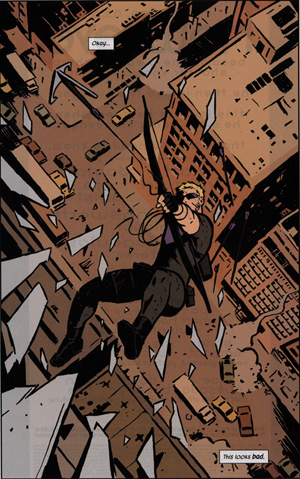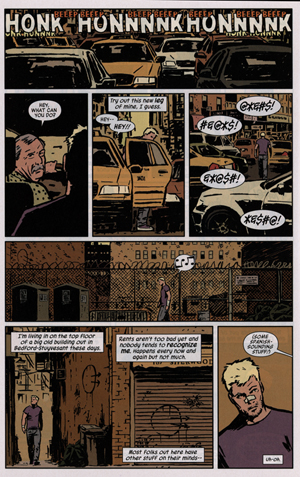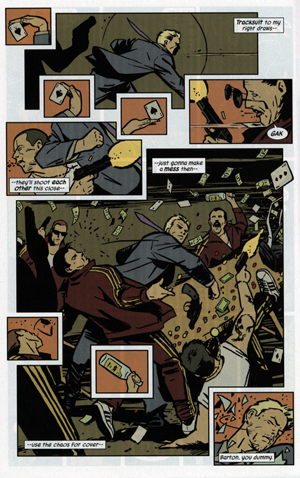And it is going to be a long read.
Second. I feel the need to at least point out who I am and where I'm coming from with this before I go into the details of this. No, I'm not doing this because I think other reviewers are bad horrible people. In fact, I don't think this is a review. This isn't being done to tell you to buy or not buy something. The goal isn't even to tell you whether a book is good or bad. Rather, I want to talk about storytelling and the comic medium. So who am I to do this? For one, I make comics. I've only been at it for a few years, but I write, pencil, letter, and study the medium intensely. There are smarter people than me and better people than me, but that combined with a degree in fine art and art history and I feel like I at least have the language to talk about the things I want to talk about. So yes: I'm nobody.
The first comic I'm going to talk about here is Hawkeye #1, from Matt Fraction, David Aja, Matt Hollingsworth, and Chris Eliopoulos. It isn't new, but it IS something I feel like I can talk about. As this goes on, some old and new comics will come in, but this is where we'll start. If you want to read along and don't have the book, it's available on Comixology if you click this link. No, I don't get anything if you do that. But it might help to follow along.
One last important thing before I get this going: I am going to do my best to talk about the book as a whole. Writing, art, color work, and lettering as one thing. That means I will do my best to not call out who did what or where, just what is right on the page and what it does. Why? Because a comic is collaborative. Without seeing the script and every communication between the various creative people, who did what is impossible to determine. So I'm not going to do that. This is also not about the story within the comic, but HOW the story is told and where and how that works or doesn't. I am also NOT referencing anything the creators of the book have talked about. This is me and just me here.
Now. I'm going to talk one page at a time, move through the story like that, and post a few images to go with it. This will likely read best if you have the book, or a digital version, in front of you, but hopefully it will read well anyway. I also apologize in advance for the quality of the images. There is some review of 'what happens' here, but hopefully only to help talk about the storytelling rather than a summary.
These are scans of the physical book, not digital versions, so I've done my best to clean up the scans a bit so they're more representative of what it looks like on the page, though you'll likely want to click on them to get a better look.
These are scans of the physical book, not digital versions, so I've done my best to clean up the scans a bit so they're more representative of what it looks like on the page, though you'll likely want to click on them to get a better look.
So here we go. Page 1. Panel 1.
Splash page. Big, dramatic, and immediately eye catching. Hawkeye's falling backwards. There are no motion lines, but a great sense of motion created by the grapple arrow in the foreground. It's flying up and to the left, against the flow of reading, while Hawkeye falls down and to the right, the direction you read the page. It's a great way to show tension and motion because if you look in the center, you can see how the line extends in BOTH directions...but also, we're only shown the ground below, so the threat of falling is far more prominent. A nice thing that's easy to miss are the arrows behind Clint, falling ahead of him. The way they're all falling randomly is a nice touch to add to the chaos of the page.
Line quality is something worth mentioning right off the bat, as well. Foreground elements like the glass are thicker and the lines in the ground are thin, which is standard for showing depth, but the eye catching thing here is the lines themselves. Everything is quick and gestural. The lines aren't even. They all have energy of their own. This gives every object a bit of energy and nothing really feels static, even the buildings.
The use of color is also immediately important to bring up. Hawkeye is in his uniform: Black and a bit of purple and his blonde hair. You've got the faintly blue tinted shards of glass and then the rest of the page is a huge amount of orange. It pulls Clint (I'm just going to use his name from now on rather than Hawkeye) forward. Again, this is pretty basic stuff, but it is also extremely effective. The other thing worth mentioning about the color is that it's flat. Flat isn't bad. It gives the book a very graphic quality, strongly complimenting the gestural lines, and also prevents a common problem of many comics: over-rendered coloring that distracts the reader. Here, you see what you need to see: the colors take your eyes directly to Clint in the center.
The next page is something that probably isn't expected, but I want to at least give it a nod: The credits page. There's some very nice and simply graphic design work here, and also a short few lines about what this book IS: This is about Clint when he's not being an Avenger. And on the immediate next page, we see Clint's fall go very bad, with some narration about his background in some fun narration. He tells the reader what he isn't all the while having a very bad fall, which is a very nice use of images and words working together.
Page 3 (not counting ads or the credits page here...) we get a single page that tells us pretty much everything about Clint as a character. This page is all character. Clint's narration is fairly obvious, but the strong yellows and oranges that dominate the page add to it and are a huge visual cue to the reader for things to come.
Page 4 is the other half of the visual cue. Everything is blue now. Clint's bleeding and the dog that we haven't yet seen looks to be in bad shape. Color is key to this issue. Yellows and oranges and we're in the past. Blues are 'now'. There are a couple of pages that are different, but overall that's the flow of things. And outside of the visually more beat-up Clint and the color shift, there is NOT indication of this time change. It's left to the reader to work out where things fit in.
Page 5 is back in the yellow and continuing the scene from Page 3, but it also has another visual element that ties the jumbled storytelling (timeline wise) together. Clint in Page 5 Panel 1 is in the same pose as Page 4 Panel 4, except now we've got a smile and no blood. The transition is also helped by the dialogue, both of which are quick mirrors of one another and keep the scenes connected.
Page 6 is still yellow. And here's a page where the color does a wonderful thing by isolating Clint. He's purple and blue and, especially in Panel 4, that pulls your eye directly to him. There's a lot going on in this page, but the color keeps you looking where you should. The framing helps as well. Again in Panel 4, there's a small area around Clint where the cars give him some visual space, as well as the word balloons surrounding him without crowding. All the elements in the panel take your eye to him. Panel 5 is good to bring up for what it does differently: Clint is walking right to left. Generally, characters should move left to right because that's how we read the books, but here it's different. Why? The transition from Panel 4 to 5 to 6 is key here. On Panel 4, you're at the far right of the page, and 5 he walks back to the left side, then in 6 he's coming out of an alley in the left corner, with arrows in the graffiti pointing to Panel 7 where his body is creation a shape that leads you to the next page.
Page 6 and 7 also are the first time we get a wonderful bit of dialogue. "(Some Spanish-Sounding Stuff!)" and "Back off, (Russian maybe?)..." This is dialogue adding to character. We've had Clint's internal monologue for a few pages now, so we're already getting a feel for his voice, and now we're truly in his head when he can't understand what's being said. It's a fun touch.
Page 8 is blue again, and Panel 1 is another repeat, this time from Page 7 Panel 8. Now the blacks are heavier and the mood of the page is darker. We even end on a silhouette. A good talky page with varied angles and actual movement in the body language.
Page 9 is red. We haven't had red before. Also note another scene change with Panel 1 mirroring the final panel of the previous scene. It's evening here and an introduction to some supporting cast. Quite a lot of character moments are packed into this one page. Panels 2, 3, and 4 create a unique looking visual effect. The bottom of Panel 2 is flanked by 3 and 4, which begin and end the action. But in the center is the target. It's nice and different and something unique to comics. Last panel has a caption that is new and another use of a color cue: Instead of white, the caption is blue. Which means...
Page 10 is blue again. We meet the dog here. Clint isn't beat up. Here's page one of the blue scenes. We've caught up so the yellow is gone from this point on. And it would be wrong of me to write all of this and not at least mention the name Pizza Dog once. More fun "bro"-filled dialogue here, as well.
Page 11, 12, and 13 are green. It's still a direct continuation of Page 10, and you can even see the blue through the door behind Clint in Page 11. Page 11 and 12 are good, moody pages of dialogue with not-too-subtle threats that some very heavy blacks only add to. And then we get the fight in Page 13. Four panels give us the card throw that starts the fight, and this time instead of the target in the center (he's last), we get Clint's full throwing motion. So you see both at once here, the step by step action, the full arc, and then the impact. And it all happens on the page at once.
Page 14 is blue and we're in the pet clinic from Page 3 again, but now we're after that point. Again, we've got transition from the previous page to the current with a similar pose: Clint being hit by the bottle, and Clint sleeping with the injury in the same pose. When the tracksuit-wearing bros enter here, we see them completely differently that before: heavy silhouettes, heads turned down, and a threatening low angle in Panel 5. We're after the fight on Page 13, but we still don't have the connective tissue between the scenes.
Page 15, 16, and 17 are that. The fight from Page 13 continues outside into blue again, and here's where something interesting happens. Panels begin to shift up and down with the lettering above or below rather than within. Instead of words within actions, here they happen separately. Page 15 Panel 2, the thought hits and then the visual along with the second thought. Page 15 Panel 4 is the opposite: Clint looks back and THEN thinks, and in the next panel continues that thought and THEN runs. This continues somewhat erratically into Page 16, but immediately stops when Clint turns around to help Pizza Dog. Now it's all in the moment again. Page 17 keeps that going, the coin trick comes back, this time traveling left to right (Usually actions like that are good to go against the flow, as it feels more sudden, but this also follows the direction Clint's hand is aiming in Panel 5. Last thing on Page 17 is that we have a scene transition happen within the page in the last three panels. Looking down, can't watch, light on the silhouette dog, and then the next panel is lit up and we're back in the clinic again.
From here on, the rest of the story is linear. Page 18 has more great-looking sound effects, and a ton of motion from the punch in Panel 3 thanks to the extreme foreground flying glasses. In Panel 4, everything is aimed at the center point: Body language, cracks in the window, folds in the clothes, and even the tails subtly take your eye to where Clint's left arm is. Panel 5 should be pointed out for the use of silhouettes and the way the villain pops because of the white stripes. No more detail, but the body language tells us everything we need to know.
Page 19 ends the scene with more exposition and strong body language. The gestural lines really pulls the page together here, as it shows us heavy rain without actually drawing a lot of rain. It's all in the negative space, especially in the final panel.
And then Page 20. Pizza Dog is fine. A nice joke, some more very strong, subtle acting through body language, and that's it. If you pay attention to the last 'panel', which doubles as a sort of title page, you also get the dog's name as the story title, a payoff to the page's joke that isn't entirely confirmed until a few issues later. Big thing here, though? One and done. This is a complete story. Clearly, more can come, but everything that was set up had a payoff.
So there we go. I'm not sure how much of this format will be the same next time I do this, or even what book the next one will be, but I can assure you more are coming. I'm open to comments on how I'm handling this, but I'll say right now I doubt I can get much less wordy. I'm a wordy person and I feel like, to do justice to this kind of thing, this kind of length is going to be important. So I hope you liked it and I hope it helps and I hope it isn't completely incomprehensible.




